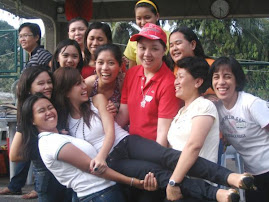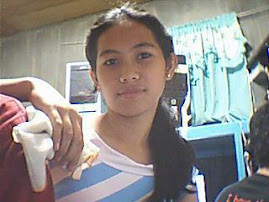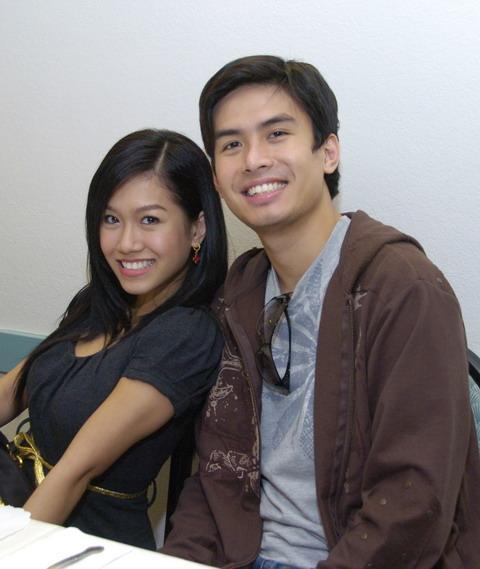Saturday, March 14, 2009
Government Websites
· 01 January 1865 OBSERVATORIO DEL ATENEO MUNICIPALPrior to this date, meteorological observations were being made by the Jesuit Fathers. Tne systematic recording of meteorological observations started on this date.
· 28 April 1884 OBSERVATORlO METEOROLOGICO DE MANILAA Spanish royal decree recognized the observatory as an official institution of the government.
· 22 May 1901 WEATHER BUREAUAct No. 131 of the Philippine Commission established the Weather Bureau.
· 08 December 1972 PAGASAPresidential Decree No. 78 reorganized the Weather Bureau into the Philippine Atmospheric, Geophysical and Astronomical Services Administration (PAGASA) and transferred it from the Department of Commerce and Industry to the Department of National Defense.
· 02 June 1977 PAGASAPresidential Decree No. 1149 amended PD No. 78. The amendments include the establishment of two additional major units. The Typhoon Moderation Research and Development Office (TMRDO) and the National Flood Forecasting Office (NFF0).
· 17 September 1984 PAGASAExecutive Order No. 984 transferred the PAGASA from the Ministry of National Defense to the National Science and Technology Authority (NSTA) and also provided from certain changes in its structure.
· 30 January 1987 PAGASA Executive Order No. 128 mandated the reorganization of the NSTA now the Department of Science and Technology (DOST) under which the PAGASA belongs.
· 01 January 1988 PAGASAPursuant to Executive Order No. 128, the PAGASA was reorganized consisting of (5) major branches and three (3) support units.
http://www.phil-lamp.org
In November 1997, the Lands Management Bureau (LMB) submitted a concept proposal to DENR which was subsequently endorsed to the World Bank through the National Economic Development Authority (NEDA). The LMB sought to improve its efficiency through the fasttracking of the issuance of patents, mass conduct of cadastral surveys and improvement of the records.
In March 1998, the World Bank sent a fact-finding mission to further investigate the country’s land administration and management problems and constraints.
A joint WB-Government of the Philippines (GOP) mission conducted field visits and dialogues/meetings with stakeholders. As a result, they prepared an Informal Policy Note [pdf file, 735kb] discussing the issues in the land sector and a framework plan to resolve these issues.
The Government responded through DENR by convening the major agencies responsible for land administration. Through these meetings, the GOP came up with long-term and short-term plans.
Since the problems are so complex and a consensus could not be reached on how to best address them, it was thought prudent to start with a small project, a World Bank Learning and Innovation Loan (LIL) was sought with a parallel AusAID TA.
In July 1999, Executive Order No. 129 creating an Inter-Agency Coordinating Committee (IACC) tasked to prepare and coordinate the implementation of a Land Administration and Management Program (LAMP).
The Project Design Preparation was financed by Australian Agency for International Development (AusAID) and, through a participatory process came up with a Project Preparation Report (PPR) [pdf file, 180kb]. The PPR was used as the basis for NEDA Board approval.
NEDA approved the Policy Statement for the Program and the 2 ½ to 3 year LIL Project last December 1999.
In March 2000, World Bank appraised the Project.
In August 2000, Loan Negotiation with the Bank was held.
In October 2000, the Loan Agreement was signed and Project became effective on January 09, 2001.
To counter a delay in the processing and approval of the Main Technical Assistance Program, the AusAID financed a bridging TA to the Project from October 2000-October 2001.
Project start-up and implementation was slowed down in the first half of year 2001 due to the change in government and appointment of DENR management.
In October, 2001, a Memorandum of Subsidiary Agreement (MSA) between the Australian government and the Republic of the Philippines thru the DENR was signed. Thus, the Main Technical Assistance Team was mobilized.
With the Main TA in place, project activities scaled-up and implementation speeded up.
In March 2002, Executive Order No. 82 was issued creating a Task Force for the Expeditious Implementation of the LAM Program. Chaired by the Senior Consultant on Poverty Alleviation and Good Governance with the Secretaries of Environment and Natural Resources, Justice, ODA Absorption and NEDA Director General and two (2) private sector representatives as members. This repealed E.O. 129 and abolished IACC.
http://bas.gov.ph
The emergence of the Bureau of Agricultural Statistics’ (BAS) was spurred by government efforts to improve the agricultural data base in the country. In the past, the agricultural data system suffered from significant gaps, some duplications and occasional issues on the relevance of some data series to users. The major reasons were: (1) the agency responsible for agricultural statistics, the then Bureau of Agricultural Economics (BAEcon), was originally set up as a user rather than a producer of statistics, (2) the development of agriculture statistics received very low priority in the sharing of limited resources allotted to the statistical system, and (3) the widespread duplication of statistical activities among government agencies resulting in conflicting figures and confusion among data users.
To address this situation, the BAS was established as one of the seven (7) bureaus of the Department of Agriculture under Executive Order No. 116 issued on January 30, 1987, to take charge of the production of statistics on agriculture, fishery and related fields. The BAS has assumed most of the functions of its predecessor, the BAEcon. In year 2000, the BAS structural organization was strengthened and reoriented pursuant to the relevant provisions of DA Administrative Order No. 6 series of 1998 in compliance with the provisions of the Agriculture and Fisheries Modernization Act or RA8435 of 1997. This law designates BAS as the central information source and server of the National Information Network (NIN) of the DA.
The Gadu-Gadu instant messenging
Gadu-Gadu uses its own proprietary protocol. As with ICQ, users are identified by unique serial numbers. Protocol's features include status messages, file sharing, and VoIP. Users may format and embed images in messages. Since client version 6.0, an experimental secure connection[vague] mode can be used.
The official client provides over 150 emoticons, allows grouping contacts, sending SMS and integrates with other services ran by the same company: a virtual Internet dial-up, a social networking site MojaGeneracja.pl and an internet radio Open.fm. Because of this, many users consider newer versions bloatware, so the older versions are still common.
Gadu-Gadu allows its users to add personal information to a "public directory", available publicly to search.
Many unofficial plugins have been created to expand its capabilities.
Reaction:
Gadu-Gadu ( GG or gg) is a Polish instant messaging client using its own protocol. Gadu-Gadu is the most popular, with over 7.8 million registered accounts and approximately users online daily.Gadu-Gadu is financed by the display of advertisements. The developer is based in Warsaw, Poland.
The Meebo instant messenging
Meebo is an Ajax-based in-browser instant messaging program which supports multiple IM services, including Yahoo! Messenger, .NET Messenger Service, Google Talk, AIM, ICQ, MySpaceIM, Facebook Chat and Jabber; it is based on the free and open source library libpurple created by the software developers of Pidgin.
Meebo also developed a version of Meebo for use on the iPhone and a native application that runs on Android mobile phones. Meebo was founded in September 2005 by Sandy Jen, Seth Sternberg and Elaine Wherry, and is based in Mountain View, California.
Reaction:
Meebo allows some people who are behind firewalled networks (networks that block the various instant messaging protocols but have not blocked the meebo.com domain name) to connect to instant messaging services due to the fact that the user connects to only port and the Meebo service itself then connects to the various instant messaging protocols.
The AIM instant messenger
AOL Instant Messenger (AIM) is an instant messaging and presence computer program which uses the proprietary OSCAR instant messaging protocol and the TOC protocol to allow registered users to communicate in real time. It was released by AOL in May 1997. Stand-alone official AIM client software includes advertisements and is available for Microsoft Windows, Mac OS, Mac OS X, and Linux. The software, maintained by AOL, LLC, has a large share of the instant messaging market, especially in the United States (with 52% of the total reported as of 2006).[1]
The standard protocol that AIM clients use to communicate is called OSCAR. Most AOL-produced versions of AIM and popular third party AIM clients use this protocol. However, AOL also created a simpler protocol called TOC that lacks many of OSCAR's features but is sometimes used for clients that only require basic chat functionality. The TOC/TOC2 protocol specifications were made available by AOL, while OSCAR is a closed protocol that third parties have had to reverse-engineer.
Reaction:AIM is different from other clients such as Yahoo Messenger in that it does not require approval from one buddy to be added to another's buddy list. As a result, it is possible for users to keep other unsuspecting users on their buddy list to see when they are online, read their status and away messages, and read their profiles. However, one can block another user from communicating and also enhance privacy by selecting a menu option allowing communication only with those on one's buddy list.
The Skyrock social networking
Skyrock.com is a social networking site offering its members a free, personal web space where they can create a blog, add a profile, and exchange messages with other registered members. The site also offers a specific space for members who create blogs showcasing their original musical compositions.
Skyrock ranks as the world’s 7th largest social network with over 21 million visitors in June 2008.
Skyrock.com began as a blogging site, Skyblog.com, founded by Skyrock CEO Pierre Bellanger in December 2002.
In May 2007, after abandoning the Skyblog.com brand , Skyrock.com was launched as a full-scale social network.
Reaction:
Massively embraced by the young generation, Skyrock.com is not always understood by older generations who associate the platform with potential dangers. Given the platform’s high penetration rate in France, Skyrock has its share of highs and lows in the public eye, and deals with its share of uses and abuses. For example, in several French middle schools, students used the platform to malign school personnel, resulting in their expulsion and in the issuing of alerts by schools to warn parents and students about such behavior.
Furthermore, certain American newspapers have attempted to associate the breakout of the Paris Riots in 2005 to usage of Skyblogs However, institutions of the French state have never filed formal complaints indicting the usage of Skyrock Blogs.
The Orkut social networking
Orkut is a social networking service which is run by Google and named after its creator, an employee of Google - Orkut Büyükkökten. The service states that it was designed to help users meet new friends and maintain existing relationships. Orkut is similar to other networking sites. Since October 2006, Orkut has permitted users to create accounts without an invitation.
Orkut is the most visited website in Brazil and second most visited site in India. A large percentage of users in India are high school and college students. The initial target market for Orkut was the United States, but the majority of its users are in Brazil and India. In fact, as of May 2008, 53.86% of Orkut's users are from Brazil, followed by India with 16.97% and 23.4% of the traffic comes from Brazil, followed by India with 18.0%. In 2008, more than 23 million of Brazilians had an account on orkut.
Reaction:
Orkut was very popular in Iran, but the website is now blocked by the government. According to official reports, this is due to national security issues, and Islamic ethical issues about dating and match making. To get around this block, sites such as orkutproxy.com (now defunct) were made for Iranian users. Other websites such as Yahoo! Groups and Google Groups have communities dedicated to receiving updates on the newest location of Iran's Orkut proxy. Though it was once possible to bypass governmental blockage of Orkut, the site has closed its HTTPS pages on all anonymous proxies. Now it is almost impossible for ordinary users to visit this site inside Iran. Many other sites have been published in Iran since Orkut's blockage, using the same social-networking model - examples include MyPardis, Cloob and Bahaneh.
The Facebook social networking
Facebook has met with some controversy over the past few years. It has been blocked intermittently in several countries including Syria[8] and Iran.[9] It has also been banned at many places of work to discourage employees from wasting time using the service.[10] Privacy has also been an issue, and it has been compromised several times. It is also facing several lawsuits from a number of Zuckerberg's former classmates, who claim that Facebook had stolen their source code and other intellectual property.
Reaction:
For me my reaction about facebook is is users may choose to join one more network,
organize that city, work place, school, and region. These network help users connect with members of the some network. Users can do also with friends, giving them all access to their friends profiles. The microsoft is facebook exclusive partner for serving banner advertising, and such as facebook only serves advertisements that exist in microsoft advertisement inventory.




















































